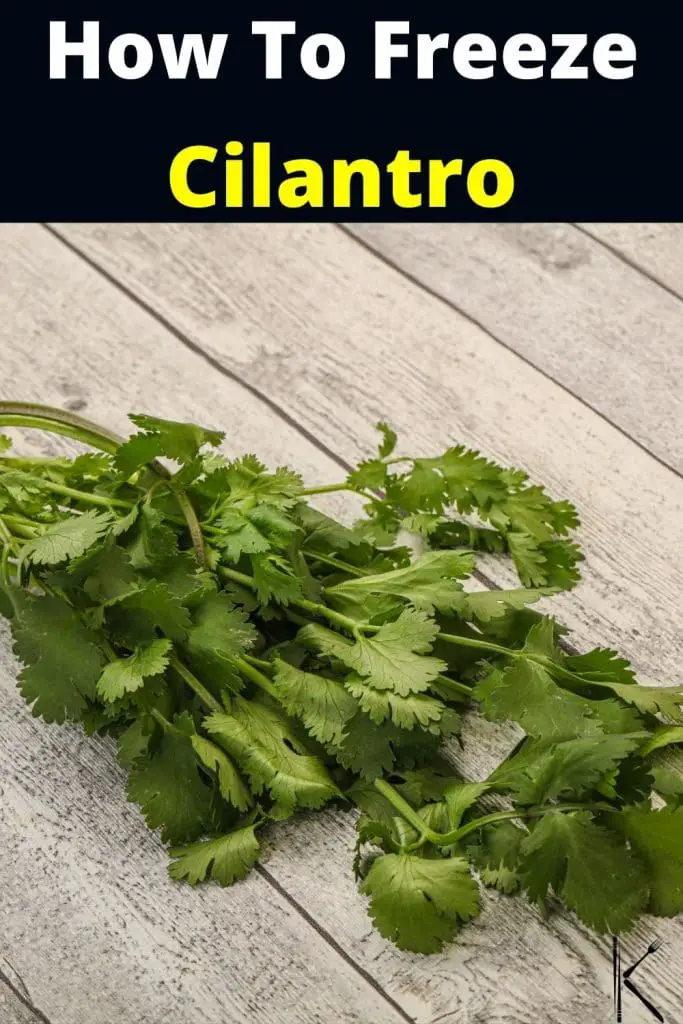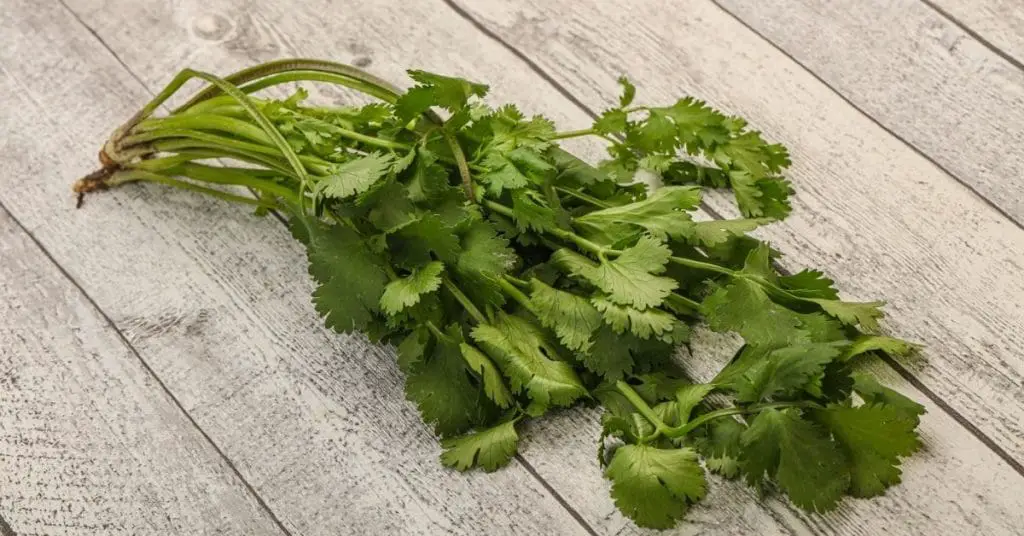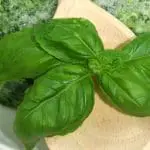Briefly, yes, you can freeze cilantro to extend its shelf life, but it will lose its texture and is best used in cooked dishes, soups, curries, and pesto rather than as a garnish or in salads. Coating the cilantro with olive oil before freezing helps preserve its color and flavor.
When it comes to fresh garden herbs, a little goes a long way. Cilantro is no different. With a very pronounced bright flavor, one cilantro bunch is enough for a few dishes.
If you are harvesting from your garden or purchased a large amount from the store, preserve cilantro by freezing the herbs before they start wilting and becoming soggy. Freezing cilantro preserves the fresh flavor better than drying the delicate herb.
Below you will find the best methods to freeze cilantro for optimal quality preservation.
Can Cilantro Be Frozen?
Yes, preserving cilantro in the freezer is a great way to extend its shelf life. It is important to consider that the fresh herb will lose its texture on freezing and won’t be suitable to use in a salad, guacamole, or as a garnish.
Frozen cilantro is great for use in cooked dishes, soup, curry, pesto, and flavored butter.
Coating cilantro lightly with olive oil before freezing helps to preserve the color and flavor of the delicate leaves.
Below you will find out how to freeze fresh cilantro best depending on how you want to use it.
How To Freeze Cilantro
Regardless of the method you choose to freeze your cilantro, the same cleaning procedures should be taken.
Always choose fresh cilantro with bright crisp leaves. Start preparing cilantro by removing any leaves that are yellowed or damaged. Rinse the cilantro well in a bowl of cold water to remove any dirt, chemicals, or bugs.
Lightly shake the water off and pat the cilantro dry with a clean kitchen or paper towel. Now choose the desired freezing method for the cilantro from the below options.
Continue to prepare the herbs accordingly:
Method 1: Bag It
Step 1: Blanch (Optional)
Blanching cilantro is optional. You can do this by dipping the cilantro in a pot of boiling water for 15 to 30 seconds and then immediately placing it in ice cold water to stop the cooking process. Once cool, pat it dry.
Blanching preserves the vibrant green color, especially if you are freezing the cilantro for a few months.
Step 2: Toss in Oil
Once the cilantro has been patted dry, toss it with a tablespoon of olive oil. For large amounts of cilantro, use a little more oil. This will keep the herbs from going mushy when frozen.
Step 3: Pack and Seal
Carefully pack the cilantro into resealable freezer bags by spreading it out evenly. You don’t want the bagged cilantro clumped up in one corner. Laying the bag flat, lightly press down to remove all the air and seal.
Step 4: Label and Freeze
Using a permanent marker, label the bag with the contents and date to keep track of how long it has been stored. Place it in the top of the freezer where other items won’t squash it.
Method 2: Ice Cube Trays
Step 1: Chop
After cleaning the cilantro, place the leaves on a cutting board. Finely chop the leaves into smaller pieces. The stems can also be included according to your preference.
Step 2: Portion and Freeze
Portion the chopped leaves into ice cube trays and top each compartment with just a little water. Place the tray in the freezer.
Step 3: Pack
Once the cilantro cubes are frozen solid, remove them from the ice cube tray and pack them into a zip top freezer bag. Keeping them in an airtight environment protects them from air and freezer burn.
Alternatively, use a freezer safe airtight container.
Step 4: Seal, Label, and Freeze
Squeeze out as much air as possible from the freezer bag as you seal it. Using a permanent marker, label the bag with the contents and date to keep track of how long it has been stored. Freeze.
Method 3: Cilantro Pesto, Oil, or Butter
Step 1: Blend
Place the cleaned cilantro into a food processor and blend until the herbs are just finely chopped. If you wish to include other ingredients such as garlic, chili flakes, or pepper, add them to the blender.
Step 2: Prepare the Oil, Butter, or Pesto
To make pesto, add any other ingredients as per your recipe and blend well. This usually includes pine nuts, olive oil, parmesan cheese, garlic, and a pinch of salt.
To make cilantro oil, pour 1/3 cup olive oil per 1 to 2 cups of chopped cilantro, depending on the preferred strength. Blend for a few seconds.
To make cilantro butter, toss the blended cilantro into a bowl with a stick of softened, room temperature butter. Use 1 to 3 tablespoons of chopped cilantro per stick of butter. Mix well until the cilantro is evenly mixed throughout.
Step 3: Portion and Freeze
Regardless of whether you are making oil, pesto, or butter, spoon your blended mixture into an ice cube tray. Only fill each compartment 3/4 of the way as the mixture needs room to expand on freezing.
Place the ice tray on a level area in the freezer. Leave it to freeze for a few hours or overnight until frozen solid.
Step 4: Pack
Remove the frozen cubes from the tray and pack them into a resealable freezer bag.
Step 5: Seal, Label, and Freeze
Squeeze out any excess air from the plastic bag as you seal it. Using a permanent marker, label the bag with the contents and date. Freeze.
How To Thaw Frozen Cilantro
Frozen cilantro or cilantro cubes can be added straight from the freezer to the dish you are cooking on the stovetop without thawing.
If you are using cilantro cubes to make a salad dressings, place the cube in a mixing bowl to defrost for 20 to 30 minutes. Once thawed, add the other ingredients to mix your dressing.
Remove frozen cilantro butter from the freezer and let it thaw at room temperature for 15 to 20 minutes before using it as a spread or topping.
Types of Cilantro
Cilantro is also known as dhania, coriander, or Chinese parsley. The entire cilantro plant, including the root, is edible, however, the fresh leaves and dried seeds are mostly used in cooking.
Cilantro leaves have a slight lemon/lime flavor, although many people liken the taste to dish soap. Fresh leaves are used in cilantro chutney, salsa, salad, guacamole starter, and can garnish almost any savory dish.
The seeds, more commonly referred to as coriander, are available whole or ground. These are used in curries, pickling, sausages, and even in brewing certain styles of beer. Cilantro root is generally only used in Asian cuisines such as Thai curry paste and soup.
Keep cilantro fresh by storing the bunches in a glass of water in the refrigerator. Bunches can also be tied and hung upside down to dry out for later use, however, cilantro does not dry out as well as other hardier herbs.
FAQs
Conclusion
Cilantro has a strong, distinctive flavor that tempers slightly when cooked. The herb is used fresh as a garnish, in salsa, salad, dressing, guacamole, and chutney. Frozen cilantro is best used in cooked dishes such as curries, sauces, soups, and stews.
Making and freezing cilantro butter is a genius way to use and store leftover herbs instead of throwing them away. This way, you always have a great herb butter on hand for omelets, toast, crackers, potatoes, and even fish or steak.
Up next: can you freeze fresh spinach?

*image by AndreySt/depositphotos









